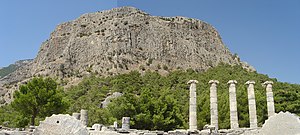
Back Slag van Mykale Afrikaans معركة ميكالي Arabic Mikale döyüşü Azerbaijani میکال دؤیوشو AZB Битка при Микале Bulgarian Emgann Mykale Breton Batalla de Mícale Catalan Bitva u Mykalé Czech Schlacht von Mykale German Μάχη της Μυκάλης Greek
| Battle of Mycale | |||||||||
|---|---|---|---|---|---|---|---|---|---|
| Part of the Second Persian invasion of Greece and the Greek counterattack | |||||||||
 Part of Mount Mycale, viewed from the ruins of Priene. | |||||||||
| |||||||||
| Belligerents | |||||||||
| Achaemenid Empire | |||||||||
| Commanders and leaders | |||||||||
| |||||||||
| Strength | |||||||||
|
| ||||||||
| Casualties and losses | |||||||||
| Considerable |
| ||||||||
The Battle of Mycale (Ancient Greek: Μάχη τῆς Μυκάλης; Machē tēs Mykalēs) was one of the two major battles (the other being the Battle of Plataea) that ended the second Persian invasion of Greece during the Greco-Persian Wars. It took place on August 27 or 28, 479 BC on the slopes of Mount Mycale on the coast of Ionia opposite the island of Samos. The battle was fought between an alliance of the Greek city-states, including Sparta, Athens and Corinth, and the Persian Empire of Xerxes I.
The previous year, the Persian invasion force, led by Xerxes himself, had scored victories at the battles of Thermopylae and Artemisium, and conquered Thessaly, Boeotia and Attica; however, at the ensuing Battle of Salamis, the allied Greek navies had won an unlikely victory, and therefore prevented the conquest of the Peloponnese. Xerxes then retreated, leaving his general Mardonius with a substantial army to finish off the Greeks the following year.
In the summer of 479 BC, the Greeks assembled an army, and marched to confront Mardonius at the Battle of Plataea. At the same time, the allied fleet sailed to Samos, where the demoralized remnants of the Persian navy were based. The Persians, seeking to avoid a battle, beached their fleet below the slopes of Mycale, and, with the support of a Persian army group, built a palisaded camp. The Greek commander Leotychides decided to attack the Persians anyway, landing the fleet's complement of marines to do so.
Although the Persian forces put up sturdy resistance, the heavily armored Greek hoplites eventually routed the Persian troops, who fled to their camp. The Ionian Greek contingents in the Persian army defected, and the camp was assailed, with a large number of Persians slaughtered. The Persian ships were then captured and burned. The complete destruction of the Persian navy, along with the destruction of Mardonius' army at Plataea, allegedly on the same day as the Battle of Mycale, decisively ended the invasion of Greece. After Plataea and Mycale, the allied Greeks would take the offensive against the Persians, marking a new phase of the Greco-Persian Wars.